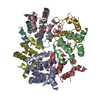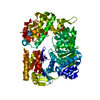+ Open data
Open data
- Basic information
Basic information
| Entry | Database: PDB / ID: 7keu | ||||||
|---|---|---|---|---|---|---|---|
| Title | Cryo-EM structure of the Caspase-1-CARD:ASC-CARD octamer | ||||||
 Components Components |
| ||||||
 Keywords Keywords | IMMUNE SYSTEM / ASC / Apoptosis-associated speck-like protein containing a CARD / PYCARD / caspase-1 / cryo-EM / helical filament / octamer | ||||||
| Function / homology |  Function and homology information Function and homology informationNLRP6 inflammasome complex / myosin I binding / Pyrin domain binding / myeloid dendritic cell activation involved in immune response / positive regulation of antigen processing and presentation of peptide antigen via MHC class II / negative regulation of protein serine/threonine kinase activity / regulation of intrinsic apoptotic signaling pathway / caspase-1 / protease inhibitor complex / myeloid dendritic cell activation ...NLRP6 inflammasome complex / myosin I binding / Pyrin domain binding / myeloid dendritic cell activation involved in immune response / positive regulation of antigen processing and presentation of peptide antigen via MHC class II / negative regulation of protein serine/threonine kinase activity / regulation of intrinsic apoptotic signaling pathway / caspase-1 / protease inhibitor complex / myeloid dendritic cell activation / AIM2 inflammasome complex assembly / IkappaB kinase complex / The AIM2 inflammasome / AIM2 inflammasome complex / IPAF inflammasome complex / The IPAF inflammasome / icosanoid biosynthetic process / NLRP1 inflammasome complex / macropinocytosis / canonical inflammasome complex / interleukin-6 receptor binding / positive regulation of interleukin-18 production / BMP receptor binding / NLRP3 inflammasome complex assembly / positive regulation of adaptive immune response / CARD domain binding / cytokine precursor processing / NLRP3 inflammasome complex / cysteine-type endopeptidase activator activity / CLEC7A/inflammasome pathway / negative regulation of interferon-beta production / Interleukin-1 processing / osmosensory signaling pathway / regulation of tumor necrosis factor-mediated signaling pathway / Interleukin-37 signaling / positive regulation of tumor necrosis factor-mediated signaling pathway / positive regulation of extrinsic apoptotic signaling pathway / pattern recognition receptor signaling pathway / cysteine-type endopeptidase activator activity involved in apoptotic process / positive regulation of macrophage cytokine production / signaling receptor ligand precursor processing / negative regulation of NF-kappaB transcription factor activity / pattern recognition receptor activity / TP53 Regulates Transcription of Caspase Activators and Caspases / tropomyosin binding / pyroptotic inflammatory response / cytokine binding / positive regulation of actin filament polymerization / positive regulation of release of cytochrome c from mitochondria / positive regulation of activated T cell proliferation / protein autoprocessing / intrinsic apoptotic signaling pathway by p53 class mediator / The NLRP3 inflammasome / positive regulation of interleukin-10 production / cellular response to interleukin-1 / intrinsic apoptotic signaling pathway in response to DNA damage by p53 class mediator / Pyroptosis / positive regulation of T cell migration / positive regulation of DNA-binding transcription factor activity / Purinergic signaling in leishmaniasis infection / positive regulation of chemokine production / positive regulation of defense response to virus by host / negative regulation of canonical NF-kappaB signal transduction / negative regulation of cytokine production involved in inflammatory response / intrinsic apoptotic signaling pathway / activation of innate immune response / positive regulation of phagocytosis / protein maturation / positive regulation of interleukin-1 beta production / tumor necrosis factor-mediated signaling pathway / positive regulation of interleukin-8 production / positive regulation of JNK cascade / apoptotic signaling pathway / cellular response to mechanical stimulus / positive regulation of non-canonical NF-kappaB signal transduction / positive regulation of NF-kappaB transcription factor activity / NOD1/2 Signaling Pathway / protein homooligomerization / regulation of protein stability / positive regulation of T cell activation / cellular response to type II interferon / positive regulation of interleukin-6 production / kinase binding / positive regulation of type II interferon production / positive regulation of inflammatory response / positive regulation of tumor necrosis factor production / SARS-CoV-1 activates/modulates innate immune responses / azurophil granule lumen / cellular response to tumor necrosis factor / cellular response to lipopolysaccharide / regulation of inflammatory response / protease binding / secretory granule lumen / regulation of apoptotic process / endopeptidase activity / defense response to Gram-negative bacterium / defense response to virus / microtubule / transmembrane transporter binding / positive regulation of ERK1 and ERK2 cascade Similarity search - Function | ||||||
| Biological species |  Homo sapiens (human) Homo sapiens (human) | ||||||
| Method | ELECTRON MICROSCOPY / single particle reconstruction / cryo EM / Resolution: 3.9 Å | ||||||
 Authors Authors | Hollingsworth, L.R. / David, L. / Li, Y. / Ruan, J. / Wu, H. | ||||||
| Funding support |  United States, 1items United States, 1items
| ||||||
 Citation Citation |  Journal: Nat Commun / Year: 2021 Journal: Nat Commun / Year: 2021Title: Mechanism of filament formation in UPA-promoted CARD8 and NLRP1 inflammasomes. Authors: L Robert Hollingsworth / Liron David / Yang Li / Andrew R Griswold / Jianbin Ruan / Humayun Sharif / Pietro Fontana / Elizabeth L Orth-He / Tian-Min Fu / Daniel A Bachovchin / Hao Wu /  Abstract: NLRP1 and CARD8 are related cytosolic sensors that upon activation form supramolecular signalling complexes known as canonical inflammasomes, resulting in caspase-1 activation, cytokine maturation ...NLRP1 and CARD8 are related cytosolic sensors that upon activation form supramolecular signalling complexes known as canonical inflammasomes, resulting in caspase-1 activation, cytokine maturation and/or pyroptotic cell death. NLRP1 and CARD8 use their C-terminal (CT) fragments containing a caspase recruitment domain (CARD) and the UPA (conserved in UNC5, PIDD, and ankyrins) subdomain for self-oligomerization, which in turn form the platform to recruit the inflammasome adaptor ASC (apoptosis-associated speck-like protein containing a CARD) or caspase-1, respectively. Here, we report cryo-EM structures of NLRP1-CT and CARD8-CT assemblies, in which the respective CARDs form central helical filaments that are promoted by oligomerized, but flexibly linked, UPAs surrounding the filaments. Through biochemical and cellular approaches, we demonstrate that the UPA itself reduces the threshold needed for NLRP1-CT and CARD8-CT filament formation and signalling. Structural analyses provide insights on the mode of ASC recruitment by NLRP1-CT and the contrasting direct recruitment of caspase-1 by CARD8-CT. We also discover that subunits in the central NLRP1 filament dimerize with additional exterior CARDs, which roughly doubles its thickness and is unique among all known CARD filaments. Finally, we engineer and determine the structure of an ASC-caspase-1 octamer, which suggests that ASC uses opposing surfaces for NLRP1, versus caspase-1, recruitment. Together these structures capture the architecture and specificity of the active NLRP1 and CARD8 inflammasomes in addition to key heteromeric CARD-CARD interactions governing inflammasome signalling. | ||||||
| History |
|
- Structure visualization
Structure visualization
| Movie |
 Movie viewer Movie viewer |
|---|---|
| Structure viewer | Molecule:  Molmil Molmil Jmol/JSmol Jmol/JSmol |
- Downloads & links
Downloads & links
- Download
Download
| PDBx/mmCIF format |  7keu.cif.gz 7keu.cif.gz | 137.5 KB | Display |  PDBx/mmCIF format PDBx/mmCIF format |
|---|---|---|---|---|
| PDB format |  pdb7keu.ent.gz pdb7keu.ent.gz | 105.9 KB | Display |  PDB format PDB format |
| PDBx/mmJSON format |  7keu.json.gz 7keu.json.gz | Tree view |  PDBx/mmJSON format PDBx/mmJSON format | |
| Others |  Other downloads Other downloads |
-Validation report
| Arichive directory |  https://data.pdbj.org/pub/pdb/validation_reports/ke/7keu https://data.pdbj.org/pub/pdb/validation_reports/ke/7keu ftp://data.pdbj.org/pub/pdb/validation_reports/ke/7keu ftp://data.pdbj.org/pub/pdb/validation_reports/ke/7keu | HTTPS FTP |
|---|
-Related structure data
| Related structure data |  22233MC  6xkjC  6xkkC M: map data used to model this data C: citing same article ( |
|---|---|
| Similar structure data | |
| EM raw data |  EMPIAR-10566 (Title: ASC-CARD:Caspase-1-CARD octamer / Data size: 1.2 TB EMPIAR-10566 (Title: ASC-CARD:Caspase-1-CARD octamer / Data size: 1.2 TBData #1: Unaligned multi-frame micrographs for the ASC-CASP1 CARD octamer [micrographs - multiframe]) |
- Links
Links
- Assembly
Assembly
| Deposited unit | 
| |||||||||||||||||||||||||||||||||||||||||||||||||||||||||||||||||||||||||||||||||||||||||||||||||||||||||||||||||||||||||||||||||||||||||||||||||||||||||||||||||||||||||||||||||||||||||||||||||||||||||||||||
|---|---|---|---|---|---|---|---|---|---|---|---|---|---|---|---|---|---|---|---|---|---|---|---|---|---|---|---|---|---|---|---|---|---|---|---|---|---|---|---|---|---|---|---|---|---|---|---|---|---|---|---|---|---|---|---|---|---|---|---|---|---|---|---|---|---|---|---|---|---|---|---|---|---|---|---|---|---|---|---|---|---|---|---|---|---|---|---|---|---|---|---|---|---|---|---|---|---|---|---|---|---|---|---|---|---|---|---|---|---|---|---|---|---|---|---|---|---|---|---|---|---|---|---|---|---|---|---|---|---|---|---|---|---|---|---|---|---|---|---|---|---|---|---|---|---|---|---|---|---|---|---|---|---|---|---|---|---|---|---|---|---|---|---|---|---|---|---|---|---|---|---|---|---|---|---|---|---|---|---|---|---|---|---|---|---|---|---|---|---|---|---|---|---|---|---|---|---|---|---|---|---|---|---|---|---|---|---|---|
| 1 |
| |||||||||||||||||||||||||||||||||||||||||||||||||||||||||||||||||||||||||||||||||||||||||||||||||||||||||||||||||||||||||||||||||||||||||||||||||||||||||||||||||||||||||||||||||||||||||||||||||||||||||||||||
| Noncrystallographic symmetry (NCS) | NCS domain:
NCS domain segments: Component-ID: _ / Refine code: _
|
 Movie
Movie Controller
Controller



 UCSF Chimera
UCSF Chimera








 PDBj
PDBj












